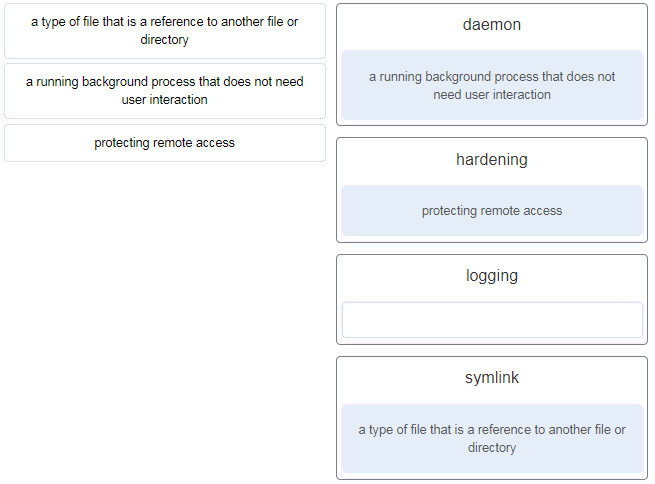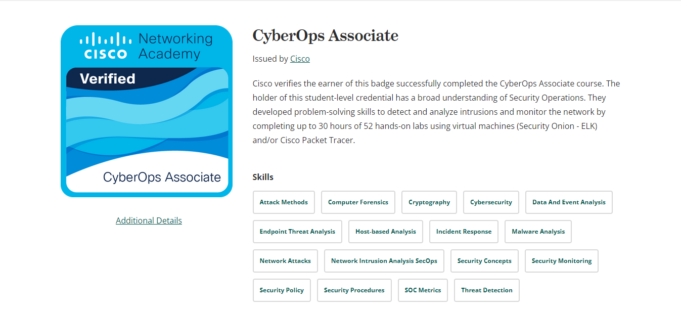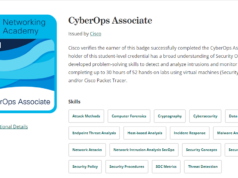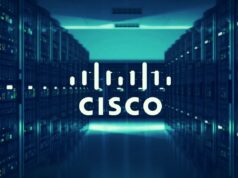CCNA Cyber Ops (Version 1.1) – Chapter 3 Exam Answers Full
1. What is the outcome when a Linux administrator enters the man man command?
- The man man command configures the network interface with a manual address.
- The man man command provides documentation about the man command. *
- The man man command provides a list of commands available at the current prompt.
- The man man command opens the most recent log file.
2. What is a benefit of Linux being an open source operating system?
- Linux distributions are maintained by a single organization.
- Linux distributions must include free support without cost.
- Linux distribution source code can be modified and then recompiled. *
- Linux distributions are simpler operating systems since they are not designed to be connected to a network.
3. Which types of files are used to manage services in a Linux system?
- Device files
- System files
- Directory files
- Configuration files *
4. Which working environment is more user-friendly?
- A CLI
- A GUI *
- The command prompt
- A hybrid GUI and CLI interface
5. Which Linux component would be used to access a short list of tasks theapplication can perform?
- Launcher
- Quicklist *
- Dash Search Box
- System and Notification Menu
6. Which term is used to describe a running instance of a computer program?
- Fork
- Patch
- Process *
- Package manager
7. Which type of tool is used by a Linux administrator to attack a computer or network to find vulnerabilities?
- Firewall
- PenTesting *
- Malware analysis
- Intrusion detection system
8. Which method can be used to harden a computing device?
- Allow USB auto-detection.
- Force periodic password changes. *
- Allow default services to remain enabled.
- Update patches on a strict annual basis irrespective of release date.
9. Consider the result of the ls -l command in the Linux output below. What are the group file permissions assigned to the analyst.txt file?
ls -l analyst.txt -rwxrw-r-- sales staff 1028 May 28 15:50 analyst.txt
- Read only
- Read, write *
- Full access
- Read, write, execute
10. Why would a network administrator choose Linux as an operating system in the Security Operations Center (SOC)?
- It is easier to use than other operating systems.
- It is more secure than other server operating systems.
- The administrator has more control over the operating system.
- More network applications are created for this environment
11. Which Linux command can be used to display the name of the current working directory?
- chmod
- pwd
- ps
- sudo
12. Consider the result of the ls -l command in the Linux output below. What are the file permissions assigned to the sales user for the analyst.txt file?
ls –l analyst.txt -rwxrw-r-- sales staff 1028 May 28 15:50 analyst.txt
- write only
- read, write, execute
- read, write
- read only
The file permissions are always displayed in the User, Group and Other order. In the example displayed, the file has the following permissions:
The dash (-) means that this is a file. For directories, the first dash would replaced with a “d”.
The first set of characters is for user permission (rwx). The user, sales, who owns the file can read, write and execute the file.
The second set of characters is for group permissions (rw-). The group, staff, who owns the file can read and write to the file.
The third set of characters is for any other user or group permissions (r–). Any other user or group on the computer can only read the file.
13. A Linux system boots into the GUI by default, so which application can a network administrator use in order to access the CLI environment?
- file viewer
- package management tool
- terminal emulator
- system viewer
A terminal emulator is an application program a user of Linux can use in order to access the CLI environment.

14. The image displays a laptop that is acting as the SSH client that is communicating with an SSH server. Refer to the exhibit. Which well-known port number is used by the server?
- 23
- 22
- 21
- 25
15. How is a server different from a workstation computer?
- The server works as a standalone computer.
- The server is designed to provide services to clients.
- The workstation has fewer applications installed.
- The workstation has more users who attach to it.
16. Which two methods can be used to harden a computing device? (Choose two.)
- Allow default services to remain enabled.
- Update patches on a strict annual basis irrespective of release date.
- Enforce the password history mechanism.
- Ensure physical security.
- Allow USB auto-detection.
17. What is the main purpose of the X Window System?
- to provide a customizable CLI environment
- to provide a basic framework for a GUI
- to provide remote access to a Linux-based system
- to provide a basic set of penetration testing tools
18. Which Linux command is used to manage processes?
- kill
- grep
- chrootkit
- ls
19. Why is Linux considered to be better protected against malware than other operating systems?
- fewer deployments
- integrated firewall
- customizable penetration and protection tools
- file system structure, file permissions, and user account restrictions
20. Which two Linux commands might be used before using the kill command? (Choose two.)
- top
- ls
- grep
- ps
- chroot
21. What term is used for operating system updates?
- patches
- new releases
- penetration testing
- packages
22. What term describes a set of software tools designed to increase the privileges of a user or to grant access to the user to portions of the operating system that should not normally be allowed?
- penetration testing
- package manager
- rootkit
- compiler
23. What is the well-known port address number used by DNS to serve requests?
- 60
- 110
- 25
- 53
24. Which file system is the primary file system used by Apple in current Macintosh computers?
- CDFS
- APFS
- ext3
- ext2
- HFS+
25. Which type of tool allows administrators to observe and understand every detail of a network transaction?
- malware analysis tool
- packet capture software
- ticketing system
- log manager
26. Which command can be utilized to view log entries of NGINX system events in real time?
- sudo journalctl –u nginx.service -f
- sudo journalctl –f
- sudo journalctl –until “1 hour ago”
- sudo journalctl –u nginx.services
27. What is the purpose of a Linux package manager?
- It provides access to settings and the shutdown function.
- It is used to compile code that creates an application.
- It is used to install an application.
- It provides a short list of tasks a particular application can perform.
28. Which user can override file permissions on a Linux computer?
- only the creator of the file
- any user that has ‘group’ permission to the file
- any user that has ‘other’ permission to the file
- root user
29. Which Linux file system introduced the journaled file system, which can be used to minimize the risk of file system corruption in the event of a sudden power loss?
- ext2
- ext3
- NFS
- CDFS
30. What is the method employed by a Linux kernel to create new processes for multitasking of a process?
- creating interdependent processes
- dynamic processes
- pipelining
- forking
31. What is a purpose of apt-get commands?
- to configure an appointment for a specific date and time
- to configure and manage task (to-do) lists
- to update the operating system
- to apportion and configure a part of the hard disk for file storage

32. Match the description to the Linux term. (Not all options are used.)
- daemon -> a running background process that does not need user interaction
- hardening -> protecting remote access
- logging -> (empty)
- symlink -> a type of file that is a reference to another file or directory

33. Match typical Linux log files to the function.
used by RedHat and Centos computers and tracks authentication related events
–> /var/log/secure
contains generic computer activity logs, and is used to store informational and noncritical system messages
–> /var/log/messages
stores information related to hardware devices and their drivers
–> /var/log/dmesg
used by RedHat and Centos computers and tracks authentication related events
–> /var/log/auth.log

34. Match the file system term used in Linux to the function.
- supports increased file sizes –> ext4
- minimizes file corruption risk in the event of power loss –> journaling
- provides hard drive space that holds inactive RAM content –> swap file system
- stores information about how the file system is organized –> MBR









